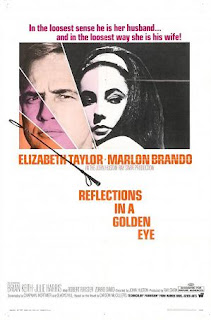Reflections in a Golden Eye
 There must have been some keen anticipation for Reflections in a Golden Eye, a 1967 film directed by John Huston and starring Elizabeth Taylor and Marlon Brando (although Brando was in his wilderness years, well before The Godfather revived his career). I'm sorry to say I found the film pretty much a dud.
There must have been some keen anticipation for Reflections in a Golden Eye, a 1967 film directed by John Huston and starring Elizabeth Taylor and Marlon Brando (although Brando was in his wilderness years, well before The Godfather revived his career). I'm sorry to say I found the film pretty much a dud.Based on a 1941 novel by Carson McCullers, the film is full of subtext. Brando plays a major on a military base in the South who is wound as tight as a spring, and he gives one of his classic, loony performances. Taylor is his wife, who enjoys nothing more than riding her white stallion, Firebird. It seems she does not ride Brando, who might be interested in an enlisted man. There's a pointed scene where Taylor takes off her clothes (a tastefully lit shot, being 1967) and taunts her husband, who responds by doing nothing except threatening to kill her, a decidedly unusual response to having a naked Liz in front of you.
Taylor is having an affair with an affable colonel, Brian Keith, who is married to a mentally disturbed woman, Julie Harris, who went to pieces after losing a baby (she took garden shears to her nipples). Harris has a fey Filipino houseboy who is about as openly gay as 1967 would allow, and allows us to make the connection between Brando's presumed repressed homosexuality.
The enlisted man, Robert Forster, is valued by Taylor because of the way he tends to her horse. He takes it a bit too far, though, and starts showing up outside the house, staring into the window (he witnesses the nude scene). Then he starts sneaking into her bedroom and watching her sleep while fondling her underwear. It's quite a film when Taylor plays one of the most sane characters.
I found the film to be so lugubrious that it almost put me into a torpor. There are many shots of Forster just staring into the distance, or Brando left to his self-indulgent mannerisms. He teaches a class on base, and I dare say he gives the oddest lecture on Clausewitz that anyone is likely to here.
The story is very reminiscent of the work of Tennessee Williams, given its Southern-fried Gothic overtones, and in the biography of currently reading on him I learned that he and McCullers were good friends, so it's not a surprise.
Also, Huston shot the film with an overwhelmingly amber hue, as if to take the title literally. It makes the film appear to be dipped in bronzer. After running in theaters that way for a week the studio took it back and made a print with a normal color palette. The DVD shows the film as Huston intended it. I'm all for the freedom of a director, but I can't say the choice added anything to the film.


Comments
Post a Comment